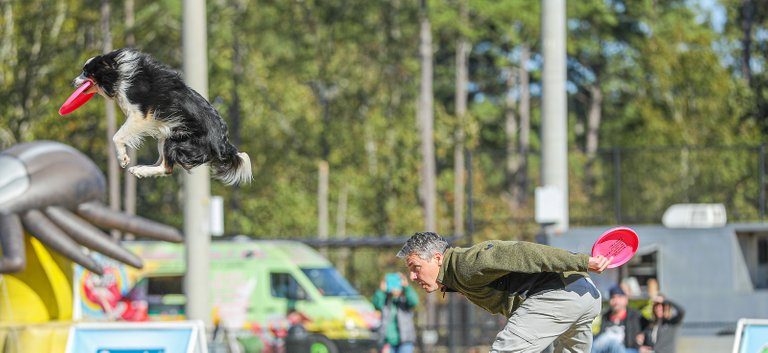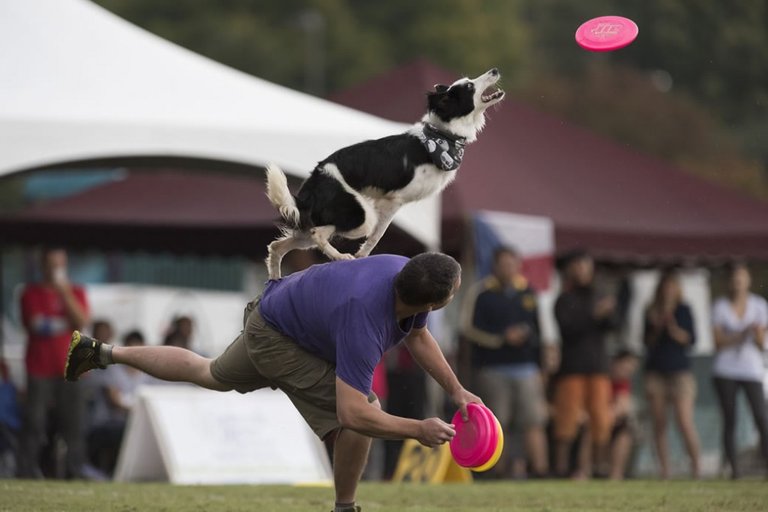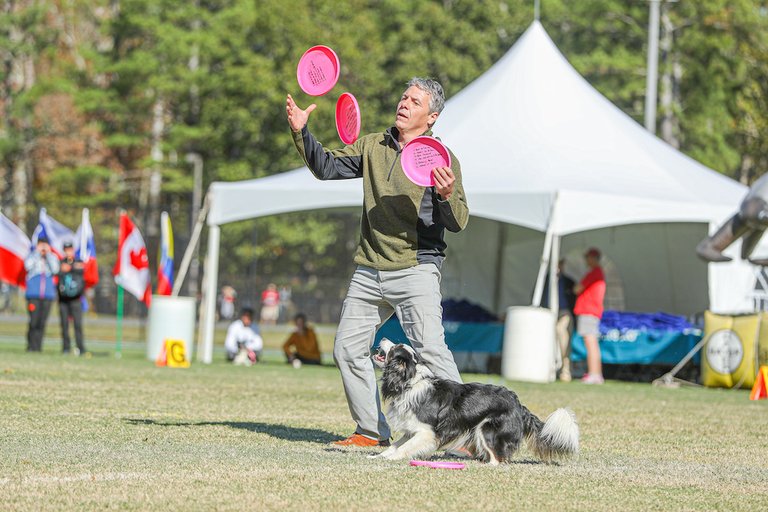
I've done a few routines in my day; from choreography in chorale in HS to a few national championship collegiate cheerleading runs to world final disc dog routines. There many ways to do a routine, here are a few formats I've identified.
Smack ‘em in the face... Coast... Smack ‘em to Close
 Smack 'em at the beginning and Smack 'em at the close is the format that Loot and I tend to use. We don't have a ton of sequences because he doesn't flip so well. So we rely on big tricks like this spinning vault on the run. We smash the open and smash the close - make a strong first impression and leave them with something memorable.
Smack 'em at the beginning and Smack 'em at the close is the format that Loot and I tend to use. We don't have a ton of sequences because he doesn't flip so well. So we rely on big tricks like this spinning vault on the run. We smash the open and smash the close - make a strong first impression and leave them with something memorable.Back in the day, this was the only one way to build a routine for me. Anything else seemed weak and unserious. Times have changed though, but this format for a routine is still super solid for anyone with a few cool tricks or sequences.
The theory is to bookend your routine with your strongest or most important 2 sequences. Start with a jaw-dropper and finish with a jaw-dropper. This makes people sit up and take notice at the start and remember how bad ass the performance was at the finish. The middle is filled with good stuff, but can be considered coasting. It is a great method; tried and true.
This routine format is not without risk though. If you miss your open, the smack in the face can seem pretentious and weak. If you miss your close, the memories are not of your badass-iness, but of a weak performance.
If your stuff is not lights out amazing, it can set up ho-hum expectations that are fulfilled with a ho-hum ending. It really is not for everyone. Sorry to all our old skool clients who were given this as the only, or best way to build a routine. Live and learn, but always love doing it.
Build to Overload and Pile On
 Building up and Piling on is totally Epic's gig. This is an Epic Juggle, a big flip followed by a fishing multiple that ends in a Front Side Back Stall. It's exactly the kind of sequence that defines the Build Up then Pile on format.
Building up and Piling on is totally Epic's gig. This is an Epic Juggle, a big flip followed by a fishing multiple that ends in a Front Side Back Stall. It's exactly the kind of sequence that defines the Build Up then Pile on format.This is something of a newer method for me. It's what I tried to apply with Eppie this year at the USDDN, and to a lesser extent at UPDIF.
The idea is to start safe and strong and to build the intensity through the middle. Once you're at peak performance, keep going. The intent is to make people start to roll their eyes right after the half way point - "WHAT!!!?" ... "C'mon!"... "No Way" ... "Did that really happen!" - with the end goal being silent awe.
I really like this format for teams that have a wide variety of tricks and skills and for teams that display tons of creativity. It's also a great way to showcase a dog that might not be the biggest athlete on the field or a highly tuned, well connected team. Punches in bunches do more damage than a single big punch - or so the theory goes.
I think this works for Epic and I. It probably wouldn't be a good fit for me and Loot.
Pillar of Consistency
It's not really the sexiest format out there, but it sure is functional, a Pillar of Consistency routine is just that; solid all the way through.
This is great for newer teams, young dogs, inexperienced handlers, and is the goto for the Technician player archetype and toss and fetch specialist.
Elements of the formats above can be added it, but the focus is on a top to bottom, rock solid routine. The key is to keep it moving and keep it fun. Lots of smiles and a few strategic pauses to highlight the amazing teamwork required to pull off a great round of disc dog freestyle.
Storytelling or Narrative
Telling a story or crafting a narrative can be a terrific routine building format. Personally, I find it the most difficult to pull off, and professionally I see it much the same.
That is not to say it isn't cool, or not a good method, but I think it's pretty tough to play top shelf disc while telling a story. And to top it off you have to tell a story, and tell it well enough, that anyone can follow it.
This method is most often used by the Showman player archetype and it relies on a good fit between the music, the style of play, and the type of dog. handler, and team.
Often hitting on particular beats and relying on crowd participation, pulling off this kind of routine at a major contest is tough but the results are totally worth it. It can be the most compelling of all formats due to the emotive investment and response of the crowd.
The rise of UpDog and the Performance Freestyle round has made this routine format much more accessible to the average team. Including costumes and props makes the storytelling and the reception of the narrative by the crowd and judges that much easier. And the effects on people's emotional state much greater.
It's Not Which or Either Or - Combination Can Be Key
Choosing a routine format does not have to be an either or proposition. In fact, great routines often have elements from all of these formats. Don't limit yourself, pigeon hole the dog, or paint the team into a corner. Just be aware of these formats and find something that works for you.
Posted from my blog with SteemPress : https://pvybe.com/disc-dog-training/on-routine-building/performance-formats-of-routines/